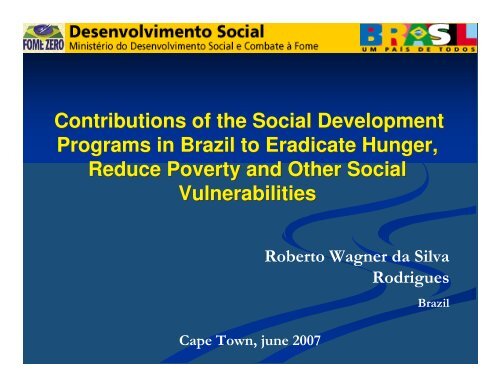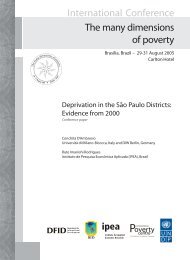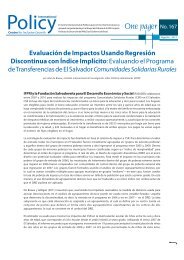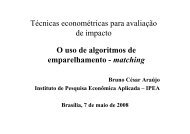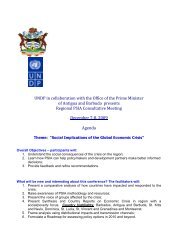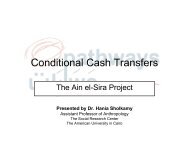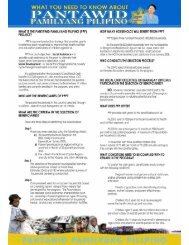Roberto Wagner da Silva Rodrigues - International Policy Centre for ...
Roberto Wagner da Silva Rodrigues - International Policy Centre for ...
Roberto Wagner da Silva Rodrigues - International Policy Centre for ...
Create successful ePaper yourself
Turn your PDF publications into a flip-book with our unique Google optimized e-Paper software.
Contributions of the Social Development<br />
Programs in Brazil to Eradicate Hunger,<br />
Reduce Poverty and Other Social<br />
Vulnerabilities
Brazilian Welfare <strong>Policy</strong> Framework<br />
SOCIAL<br />
PROTECTION<br />
Cash<br />
Transfer<br />
SOCIAL<br />
DEVELOPMENT<br />
Social Welfare<br />
Full Provision<br />
Social Welfare<br />
Partial Provision<br />
Incentives to participate or<br />
return to the labor market<br />
Support to Rural Economic Activities
Brazil<br />
•Population: 180 million<br />
•5 regions<br />
•Area: 8,514,215.3 km²<br />
Source: Ministry of Social Development and Fight Against Hunger<br />
•26 States and the Federal District<br />
5,564 municipalities<br />
•Poor families: Approximately 11.2<br />
million families (44 million people)<br />
•Extremely poor families:<br />
Approximately 4.5 million families
30.000,0<br />
25.000,0<br />
20.000,0<br />
15.000,0<br />
10.000,0<br />
5.000,0<br />
-<br />
Budget Evolution of MDS - 2004 a 2007<br />
1real ~2dollars<br />
2004 2005 2006 2007<br />
Between 2004 and 2006 budget execution was around 97%<br />
Lei + Créditos<br />
Liqui<strong>da</strong>ção
History and Basic Features<br />
Inclusion of social assistance as a basic right in the<br />
1988 constitution (independent of social security<br />
contribution)<br />
Many legislative actions to <strong>for</strong>malize social assistance (<br />
Organic Law of Social Assistance - 1993)<br />
CCT Initiatives in Campinas and in the Federal District –<br />
1995<br />
ZERO HUNGER – 2003 january<br />
Bolsa Familia – september 2003<br />
Separation of contributive and non-contributive non contributive social<br />
protection with the creation of MDS - 2004<br />
Creation of SUAS (Single System of Social Assistance).
Alleveate poverty<br />
Promoting health<br />
Empowerment of the<br />
families<br />
BF Objectives<br />
Direct cash transfer<br />
(short term) term<br />
Health atten<strong>da</strong>nce as<br />
conditin to stay in<br />
(mid mid-term term)<br />
Education atten<strong>da</strong>nce<br />
and continuation(long<br />
continuation long<br />
term) term<br />
Link to complimentary<br />
services
Obtained Results in Social Management:<br />
a) Merger of four income-transfer programs, which had been spread out<br />
among four different ministries, into one, called Bolsa Família (family<br />
fund). This pays up to 95 reais ($48) a month to 11.1m of Brazil's poorest<br />
families (achieved in 2006).<br />
b) The Bolsa Família Program has been recognized by independent studies<br />
as world example of a well focused initiative to alleviate poverty<br />
c) BF has increased atten<strong>da</strong>nce and reduced dropout rates<br />
d) Breaks down clientelism and helps to strength the notion of Social Rights<br />
in the field of Social <strong>Policy</strong> and Social Assistance<br />
e) More efficiency and transparency, using In<strong>for</strong>mation systems to aid<br />
social management<br />
f) Improvement of programs and actions by using in<strong>for</strong>mation<br />
as a result of social research realized by independent<br />
institutions.
Survey with beneficiaries of the Bolsa<br />
Familia Program, december 2004<br />
Bolsa Familia Program image among<br />
beneficiated families<br />
Bolsa Família allows attended families to have<br />
better quality and variety nourishment<br />
Bolsa Família allows attended families<br />
consume a greater amount of food per family<br />
member<br />
Agree<br />
93,1%<br />
92,5%<br />
Over 75% of the families spend more than 75% of the<br />
benefit with food.
Bolsa Familia elegibility<br />
Extreme poverty<br />
Situation of poverty<br />
Eligibility<br />
Amount per<br />
capita<br />
Up to U$30.00<br />
U$30 to U$60<br />
Benefit<br />
Basic = $25.00<br />
+ 7.5 per child<br />
up to three<br />
children<br />
No basic benefit<br />
+ $7.5 up to<br />
three children
Per<strong>for</strong>mance of<br />
Policies, Programs<br />
and Actions
Three Pillars mark MDS social actions: actions:<br />
1. Fight against Hunger and Malnutrition<br />
2. Reduction of poverty and inequality<br />
3. Enlargement of the network of Social<br />
Assistance Services (SUAS)
1) Fight Against<br />
Hunger and<br />
Malnutrition
Landmarks of the <strong>Policy</strong> <strong>for</strong> Food and Nutritional Security<br />
a) Reactivation and strengthening of CONSEA in 2003<br />
b) Approval of the Organic Act of Social Assistance<br />
(LOSAN), in 2006<br />
Principal MDS programs that aim to guarantee access to food:<br />
a) Bolsa Família Program<br />
b) Food Acquisition Program - PAA<br />
c) Cistern Program<br />
d) Decentralized systems <strong>for</strong> food security (Restaurantes Populares<br />
Program (low-income restaurants); Community Kitchens; Food<br />
Banks; Community Gardens)<br />
e) Food Baskets
Some Results from the Fight Against Malnutrition<br />
In the Semi-arid region, participation in Bolsa Família<br />
reduced the risk of chronic malnutrition in children under<br />
five by 30%<br />
The largest benefit was seen <strong>for</strong> children between the<br />
ages of 6 and 11 months, <strong>for</strong> whom there was a 62%<br />
reduction in the risk of chronic malnutrition.<br />
Source: Inquiry “Chama<strong>da</strong> Nutricional” – MDS/MS 2006.
Other contributions from Bolsa Família<br />
85.6% of the benefited families consider that the family’s<br />
food either “improved” or “improved greatly” after the start<br />
of the program.<br />
94,2% of the benefited families declare that children under<br />
the age of five eat three or more meals per <strong>da</strong>y.<br />
Source: DataUFF/Ufba/MDS, 2006.
Food Acquisition Program (PAA):<br />
Approximately one billion reals were invested in the<br />
program between 2003 and 2006, benefiting 114<br />
thousand farmers.<br />
In 2006, the food acquired through the PAA was destined<br />
<strong>for</strong> approximately 7 million people who were in situations<br />
without food or nutritional security.<br />
PAA-Milk<br />
The program buys 700 thousand liters of milk/<strong>da</strong>y<br />
distributing the product to 647 thousand families <strong>da</strong>ily.
Furthermore, the PAA contributes to the development<br />
of Family Agriculture<br />
PAA<br />
• Elevation in the income and insertion of farmers into local markets.<br />
• Family farmer beneficiaries possess receipts of commercialization of<br />
agriculture production almost three times greater than non<br />
beneficiaries – a difference associated with sales to the PAA<br />
PAA-Milk PAA Milk<br />
Source: USP/FEALQ (2006)<br />
• Has provoked growth and stability in the market and elevation in the<br />
levels of employment and income in regions benefited by the<br />
Program.<br />
Source: UFPE (2006)
Cistern Construction in the Semi-Arid<br />
A partnership between the MDS and the Association <strong>for</strong> the Semi-arid (ASA)<br />
enabled the construction of 200 thousand cisterns, benefiting 800 thousand<br />
people. From 2003 to 2006, the MDS invested 273 million reals in the<br />
program.<br />
26.4% of the benefited families spent more than 2 hours per <strong>da</strong>y transporting<br />
water. This percentage dropped to 3% after the construction of a cistern.<br />
According to declarations made by those interviewed, the percentage of<br />
people who had diarrhea fell from 22% to 0.58%.<br />
Perceptions of the family of the quality of water consumed:<br />
• Be<strong>for</strong>e the cistern: Good 22% Horrible 22%<br />
• After the Cistern: Good 96% Horrible 0.69%<br />
Source: Embrapa/MDS, 2006.
Fight Against Poverty
The cash transfer programs have contributed to the<br />
reduction of poverty and inequality in the country<br />
Bolsa Família : Fulfillment of Service goals<br />
2003: 1.2 million families serviced<br />
2006: 11.1 million families serviced<br />
Expansion of services of Continued Cash Benefits<br />
(BPC/LOAS) :<br />
2003: 1.7 million beneficiaries<br />
2006: 2.5 million beneficiaries
Coverage of Bolsa Família (%), Brazil, October-2003<br />
Source: MDS/SAGI e IPEA, Nota: (1) Coverage = Number of families benefited in Oct/2003,<br />
divided by the estimated number of poor families<br />
1.2 million beneficiary<br />
families
Coverage of Bolsa Família (%), Brazil, December -2006<br />
Source: MDS/SAGI e IPEA, Nota: (1) Coverage = Number of benefited families in Jul/2006,<br />
divided by the estimated number of poor families<br />
11 million beneficiary<br />
families
Bilhões de Reais (R$)<br />
18,00<br />
16,00<br />
14,00<br />
12,00<br />
10,00<br />
8,00<br />
6,00<br />
4,00<br />
2,00<br />
0,00<br />
Evolution of applied resources <strong>for</strong><br />
PBF e BPC- Brazil, 2003-2006<br />
Bolsa Família BPC<br />
4,53<br />
0,57<br />
5,81<br />
3,79<br />
7,52<br />
5,69<br />
2003 2004 2005 2006<br />
9,72<br />
7,52
% <strong>da</strong> população<br />
37,0<br />
34,0<br />
31,0<br />
28,0<br />
25,0<br />
22,0<br />
1992<br />
35,16<br />
The Fall of Misery in Brazil<br />
1993<br />
35,31<br />
1994<br />
28,79<br />
28,99<br />
28,5<br />
Source: CPS/FGV starting with micro<strong>da</strong>ta from PNAD/IBGE.<br />
1995<br />
1996<br />
1997<br />
1998<br />
Defined as the proportion of the population with a per capita income of less than R$121 to to<strong>da</strong>y’s prices from São Paulo,<br />
adjusted by regional differences in the cost of living. Obs: 1994 and 2000 are averages of adjacent years. In those years,<br />
PNAD did not conduct surveys.<br />
27,18<br />
1999<br />
28,38<br />
2000<br />
2001<br />
27,63<br />
2002<br />
26,72<br />
2003<br />
28,17<br />
22,77<br />
2004<br />
25,38<br />
2005
0,610<br />
0,600<br />
0,590<br />
0,580<br />
0,570<br />
0,560<br />
Evolution of the Gini index<br />
0,583<br />
0,607<br />
0,599<br />
0,602<br />
0,600<br />
0,600<br />
0,594<br />
0,596<br />
0,589<br />
0,583<br />
0,572<br />
0,568<br />
1992 1993 1995 1996 1997 1998 1999 2001 2002 2003 2004 2005<br />
Source: CPS/FGV using micro <strong>da</strong>ta from PNAD/IBGE.
Contribution of cash transfer programs in the fall of<br />
income inequality 1995-2004<br />
Cash transfers from social program were<br />
responsible <strong>for</strong> 28% of the drop in inequality<br />
during the period (as measured by the Gini index)<br />
Bolsa Família – 21%<br />
BPC – 7%<br />
Sources: SOARES,F.V., SOARES,S., MEDEIROS, M. e OSÓRIO, R. 2006 “CASH TRANSFER<br />
PROGRAMMES IN BRAZIL: IMPACTS ON INEQUALITY AND POVERTY” – Working Paper,21
Percentual Médio de Incremento na Ren<strong>da</strong><br />
Impact of PBF on Beneficiary Per<strong>for</strong>mance<br />
August/2006<br />
45,0<br />
40,0<br />
35,0<br />
30,0<br />
25,0<br />
20,0<br />
15,0<br />
10,0<br />
5,0<br />
0,0<br />
36,8<br />
39,8<br />
41,0<br />
Average rise of 36.8% in the income of beneficiary families, resulting in 2.5<br />
million families rising above the line of extreme poverty<br />
Source: Study SAGI/MDS with a base in the <strong>da</strong>ta from Unified Registry (SENARC – August, 2006) e Payment<br />
sheets from PBF (CAIXA ECONÔMICA FEDERAL- August, 2006)<br />
32,0<br />
29,6<br />
28,0<br />
BRASIL Norte Nordeste Sudeste Sul Centro-<br />
Oeste
Enlargement of the<br />
Provision of Social<br />
Assistance Services
Social Assistanc epasses through profound<br />
changes in Brazil<br />
SUAS organizes, <strong>for</strong> the first time in the history of the<br />
country, services, programs, and benefits destined <strong>for</strong><br />
around 50 million Brazilians, in all age groups.<br />
The new system is the fruit of almost two decades of<br />
debate and places in practice precepts from the 1988<br />
Constitution<br />
The diverse actions and initiatives of service to the needy<br />
population leave the realm of volunteerism and into the<br />
structure of a National public policy.
2.500<br />
2.000<br />
1.500<br />
1.000<br />
500<br />
0<br />
901<br />
• Annual service capacity in these CRAS is of 1.8 million families<br />
• R$ 486 were invested in this service<br />
Number of CRAS<br />
1.978<br />
2.232<br />
2004 2005 2006<br />
• The expansion of one thousand new CRAS <strong>for</strong> the year 2007 was assigned
Principle advances in the protection of children and<br />
adolescents<br />
• PETI: Integration with Bolsa Família; expansion from 809<br />
thousand, in 2003, to 1,042,064 children in 2006, reaching<br />
3,388 municipalities<br />
• Agente Jovem: Enlargement of service of the program<br />
from 56 thousand, in 2004, to 112 thousand beneficiaries<br />
in 2006<br />
• Confrontation with the Abuse and Sexual Exploitation of<br />
Children and Adolescents: Enlargement of service of the<br />
program from 17.8 thousand, in 2004, to 63.3 thousand<br />
children in 2006
Articulation<br />
and<br />
Partnerships
Donations collected from 2003 to 2007* 2007<br />
Donations to the Fund <strong>for</strong> the<br />
Fight and Eradication of<br />
Poverty<br />
Goods Donated<br />
Infrastructure and Services<br />
of the Head Office of Fome<br />
Zero Relations 0800<br />
Strategic Partnerships<br />
TOTAL<br />
R$ 13,800,000.00<br />
R$ 30,960,000.00<br />
R$ 46,900,000.00<br />
R$ 477,000,000.00<br />
R$ 568,660,000.00
Evaluation<br />
and<br />
Monitoring
Evaluation and Management of In<strong>for</strong>mation<br />
2004 to 2006<br />
Investment of R$ 34,538,851.66 in research<br />
(equivalent to 0.14% of evaluated social<br />
program budgets)<br />
35 evaluations of social programs concluded<br />
with the realization of 203 thousand interviews<br />
26 publications with a circulation of 99,580<br />
copies
Evaluation and Management of In<strong>for</strong>mation<br />
2004 to 2006<br />
System of In<strong>for</strong>mation with a base in varied <strong>da</strong>ta<br />
including:<br />
Creation of in<strong>for</strong>mational tools (Social In<strong>for</strong>mation<br />
Matrix, DICI-Vip DICI Vip. . Visualizer of BF and Module of Social<br />
Maps)<br />
Monitoring of 87 indicators of social programs<br />
483 disposable thematic maps
Demands<br />
and<br />
Perspectives
Increase of the values of the benefits<br />
Adjustments and finalization in the Program<br />
design<br />
Amplification of the offer of complimentary<br />
programs<br />
Finalization of the design <strong>for</strong> integration other<br />
programs<br />
Improvement of shared management of the<br />
program with federal entities, mainly the states
More effective articulation of PBF with policies of youth support<br />
Perfecting of “focalização”, with active searching <strong>for</strong> the most excluded<br />
Perfecting of methodology <strong>for</strong> estimating the number of poor families<br />
Enlargement of utilization of the Unique Registry as an instrument <strong>for</strong><br />
identification of the beneficiaries <strong>for</strong> social programs created <strong>for</strong> poor<br />
families<br />
Ampliação <strong>da</strong> utilização do Ca<strong>da</strong>stro Único como instrumento para<br />
identificação de beneficiários para programas sociais voltados para<br />
famílias pobres<br />
Qualifaction of municipal and state managers and technicians<br />
Finalization of audit process, of development of systems<br />
Continued improvement in the relation with the Caixa
Implementation of LOSAN and consoli<strong>da</strong>tion of<br />
SISAN.<br />
Analysis and evaluation of the impact of SAN<br />
policies, with visits and elaboration of the PPA<br />
2008/2011<br />
Improvement in the mechanisms of inspection<br />
and control of programs under the Secretariat.<br />
Organizational and human resource<br />
improvements <strong>for</strong> better per<strong>for</strong>mance of the<br />
functions of SESAN
Universalization of the CRAS and consoli<strong>da</strong>tion of the<br />
articulation of basic protection services with cash<br />
transfer programs; control and accompaniment of<br />
vulnerable families; encourage the offer of projects of<br />
productive inclusion.<br />
Universalization of service to children/adolescents in<br />
labor situations<br />
Reordering and intensification of investments in<br />
services and in the physical restructuring in the<br />
service network<br />
Elaboration, approval, and execution of the Decennial<br />
Plan
Deepen and regulate the aid services<br />
Carry out the management pact with state<br />
governments<br />
Consoli<strong>da</strong>tion and build up of the SUAS network<br />
Organization of the special social protection in a<br />
systematic manner
Strengthening of the transfer of the resources “fundto-fund”<br />
Continuity of the process of regulation of services<br />
and benefits<br />
Consoli<strong>da</strong>te the social control of the policy of Social<br />
Assistance<br />
Development of qualification of Social Assistance<br />
actors<br />
Employ a preventative model in the Social<br />
Assistance policy
•Bolsa Família<br />
•Unique Registry<br />
Other Programs of MDS<br />
•Food Acquisition Program – PAA<br />
•Cisterns<br />
•CONSADs (local Development<br />
Concils)<br />
•Popular Restaurants (low-income)<br />
•Food Banks<br />
•Community Kitchens<br />
•Food Basket Distribution<br />
•Urban Agriculture<br />
•Food and Nutrition Education<br />
•Educational Booklets<br />
•Quilombo Community Support<br />
•BPC/LOAS/RMV : Elderly e Disabled<br />
•Integral Family Care Program – PAIF<br />
•Social Assistance Reference Centers<br />
– CRAS<br />
•Social Assistance Specialized<br />
Reference Centers – CREAS<br />
•Continued Services <strong>for</strong> the service of<br />
children, family, and elderly<br />
• Child Labor Eradication Program -<br />
PETI<br />
•Youth Agent Program <strong>for</strong> human<br />
development
Thank you! you!


